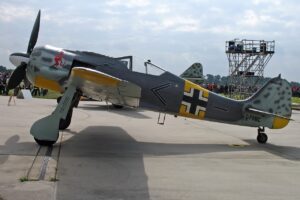 In every army, navy, and air force, there are exceptional soldiers…even among the enemy. During World War II, the German Luftwaffe had an incredible pilot. His name was Erich Rudorffer, and he is credited with shooting down thirteen Soviet aircraft in a single mission on October 11, 1943. In that historic mission while flying an FW-190, Rudorffer downed eight Yak-7s and five Yak-9s of the Soviet Air Force. He eventually shot down 222 enemy aircraft and ended up his combat career flying the Messerschmitt ME-262, the first operational jet fighter.
In every army, navy, and air force, there are exceptional soldiers…even among the enemy. During World War II, the German Luftwaffe had an incredible pilot. His name was Erich Rudorffer, and he is credited with shooting down thirteen Soviet aircraft in a single mission on October 11, 1943. In that historic mission while flying an FW-190, Rudorffer downed eight Yak-7s and five Yak-9s of the Soviet Air Force. He eventually shot down 222 enemy aircraft and ended up his combat career flying the Messerschmitt ME-262, the first operational jet fighter.
Still, it wasn’t just the number of planes he shot down that made him remarkable. It was also the fact that he managed to survive the war despite flying over 1000 missions and being shot down an incredible 16 times. He was even forced to parachute from his stricken fighter planes 9 of those times. Not just a Soviet killer, Rudorffer also shot down 86 aircraft operated by Western Allied air forces. He became a commercial pilot after World War II.
Rudorffer was born on November 1, 1917, in Zwochau, which was a part of the Kingdom of Saxony of the German Empire at that time. Strangely, or maybe not, very little is said or known about his parents. That was typical of the German leadership of that era. They felt like the state, and not the parents should raise the children, because…well, parents had no training in such things. Not that the German leadership did either, but they decided that they knew more than the parents, so they pulled the children from their parents’ homes and put them in boarding schools to “train” them in the German ways. After his graduation from school, Rudorffer received a vocational education as an automobile metalsmith specialized in coachbuilding, which was likely another of the German or “Nazi” way of deciding the course of the lives of the children. He might have stayed a mechanic were it not for World War I. “Rudorffer joined the military service of the Luftwaffe with Flieger-Ersatz-Abteilung 61 (Flier Replacement Unit 61) in Oschatz on April 16, 1936. From September 2 to October 15, 1936, he served with Kampfgeschwader 253 (KG 253—253rd Bomber Wing) and from October16, 1936 to February 24, 1937, he was trained as an aircraft engine mechanic at the Technische Schule Adlershof, the technical school at Adlershof in Berlin. On March 14, 1937, Rudorffer was posted to Kampfgeschwader 153 (KG 153—153rd Bomber Wing), where he served as a mechanic until end October 1938. After that, he was transferred to Flieger-Ersatz-Abteilung 51 (Flier Replacement Unit 51) based at Liegnitz in Silesia, present-day Legnica in Poland, for flight training. Rudorffer was first trained as a bomber pilot and then as a Zerstörer, a heavy fighter or destroyer, pilot. In the winter of 1944 Rudorffer was trained on the ME 262 jet fighter. In February 1945, he was recalled to command I. Gruppe JG 7 “Nowotny” from Major Theodor Weissenberger who replaced Steinhoff as Geschwaderkommodore. Rudorffer claimed 12 victories with the ME 262, to bring his total to 222. His tally  included 136 on the Eastern Front, 26 in North Africa, and 60 on the Western Front including 10 heavy bombers.”
included 136 on the Eastern Front, 26 in North Africa, and 60 on the Western Front including 10 heavy bombers.”
After the war ended, Rudorffer started out flying DC-2s and DC-3s in Australia. Later, he worked for Pan Am and the Luftfahrt-Bundesamt, Germany’s civil aviation authority. Rudorffer was honored as one of the characters in the 2007 Finnish war movie “Tali-Ihantala 1944.” A FW 190 participated, painted in the same markings as Rudorffer’s aircraft in 1944. The aircraft, now based at Omaka Aerodrome in New Zealand, still wears the colors of Rudorffer’s machine. Rudorffer died in April 2016 at the age of 98. At the time of his death, he was the last living recipient of the Knight’s Cross of the Iron Cross with Oak Leaves and Swords.


Leave a Reply